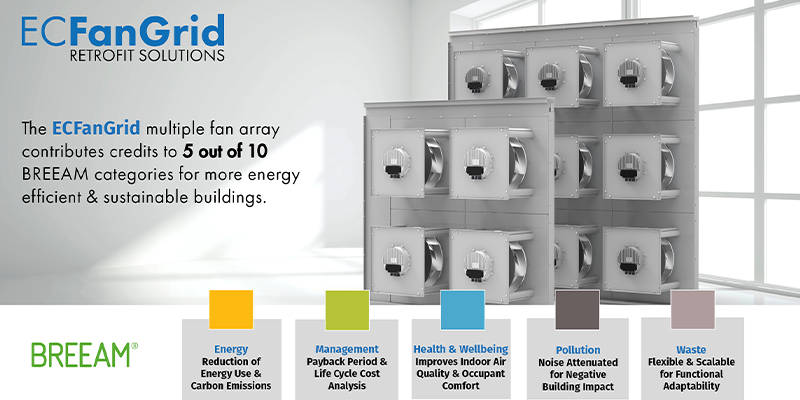
10 January 2025 | Axair Fans
BREEAM Credits for Reducing Emissions With AHU Upgrades
In accordance with the greenhouse gas (GHG) protocol, which measures carbon emissions from private and public sector operations, UK universities must now record their Scope 1 & 2 carbon emissions with a view to achieving net zero status in the future.
Credits can be earned in the Energy category of BREEAM assessments through implementing solutions that improve the buildings operational energy use. Universities were set a challenge to reduce their carbon emissions by 43% between 2005 and 2021. It has been reported however, that up to 59% did not meet these targets. By 2030, this target is a 63% reduction in carbon emissions so there’s still a large way to go.So how can we help universities and other education institutions reduce their overall emissions. Firstly, let’s understand how carbon emissions are categorised.
Emissions are broken down into three scopes:
To create a carbon reduction plan, it is necessary to identify all carbon emissions generated from usual business operations. From here, improvements can be made to reduce emissions from each contributory set.
Scope 1 emissions are direct emissions, such as those generated from the purchase of gas and electricity. For example, natural gas.
Scope 2 emissions are indirect emissions such as the carbon emissions generated from using electricity to power equipment in the buildings.
Scope 3 emissions are indirect from other activities such as distribution, air, and road travel, not usually associated with the building itself.
In January 2023, The Royal Anniversary Trust released a report titled “Accelerating towards Net Zero” in which it estimated the total carbon footprint for the tertiary education sector across all three scopes was 18.1Mt CO2e, with higher education contributing approximately 86% of this.
Scope 1 & 2 Emissions and The Built Environment
Scope 1 and 2 emissions relate predominantly to the building and infrastructure, the daily business activities, and operations of the building. How energy efficient these activities, processes and equipment’s are, has a large impact on the potential to reduce scope 2 carbon emissions. The report mentioned above identified three key action pathways to achieving net zero, with one of these being the Built Environment.
19% of the sectors total emissions are related to the built environment representing scope 1 & 2 fuel and electricity use, as well as scope 3 emissions.
What Scope of Carbon Emissions do Air Handling Units Fall into?
As specialists in fan integration and air handling retrofit, we work on many projects to reduce overall energy efficiency. Energy efficiency, energy consumption and carbon emissions go hand in hand.
Air handling units (AHUs) typically fall under Scope 2 carbon reduction. As touched on earlier, scope 2 emissions refer to the indirect GHG emissions associated with the production of purchased electricity, heat, or steam that a company or organisation consumes. AHUs consume electricity to power fans and motors, which result in indirect carbon emissions associated with the electricity used.
To reduce scope 2 emissions associated with AHUs, we focus on increasing the energy efficiency and reducing carbon output associated with our customers AHUs. This is especially true if we’re replacing large centralised single systems with old and inefficient belt driven fans. In the case of new systems, new multiple fan array air handling units, are designed to ensure fans and motors run closer to their peak efficiencies, thus contributing to a lower energy consumption and carbon emission output. For example, EC plug fans used in our ECFanGrid retrofit projects in 2019, reduced CO2 by 2980t in one year, with over 5987MW energy savings per year. The average payback period following the initial investment was on average between 2-5 years.
Scope 2 Carbon Emission Reduction & BREEAM
Reducing Scope 2 emissions associated with AHUs can be an important part of a universities carbon reduction strategy and can contribute to their overall sustainability goals. Reducing energy use and carbon reduction techniques are well credited within the Energy category of BREEAM assessments. Our air handling units contribute credits within 5 out of 10 BREEAM categories with scope 2 carbon emission reduction adding value in Ene.01 Reduction of energy use and carbon emissions.
How Does the Carbon Reduction Fund Help Universities?
By reducing their carbon emissions, universities can not only help to mitigate climate change but also reduce their energy costs and demonstrate their commitment to sustainability. The Carbon Reduction Fund is a financial support programme that provides universities with the resources and support they need to implement sustainability projects, such as upgrading buildings to be more energy-efficient, investing in renewable energy sources, and promoting sustainable transportation options.
In addition to the environmental benefits, participating in the Carbon Reduction Fund can also provide UK universities with reputational benefits. By demonstrating their commitment to sustainability, universities can enhance their brand and attract environmentally conscious students, staff, and stakeholders.